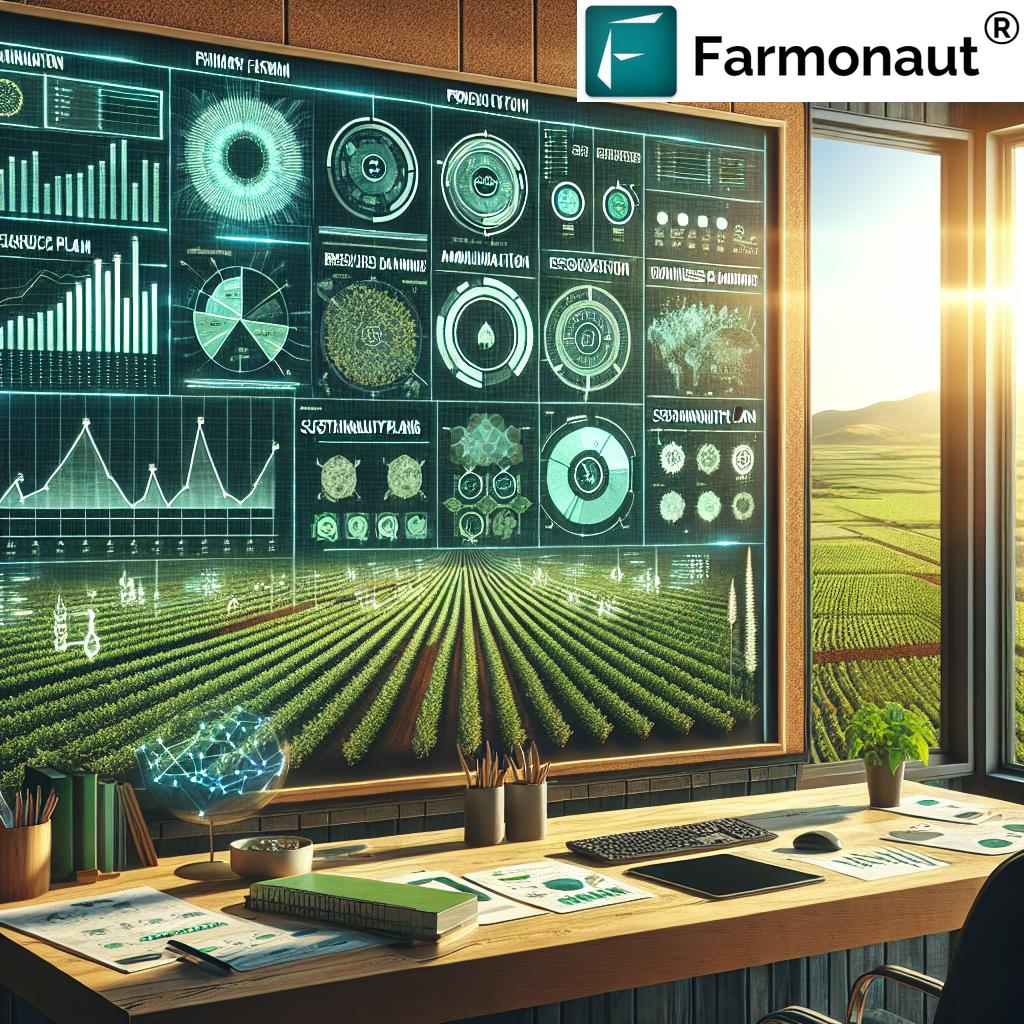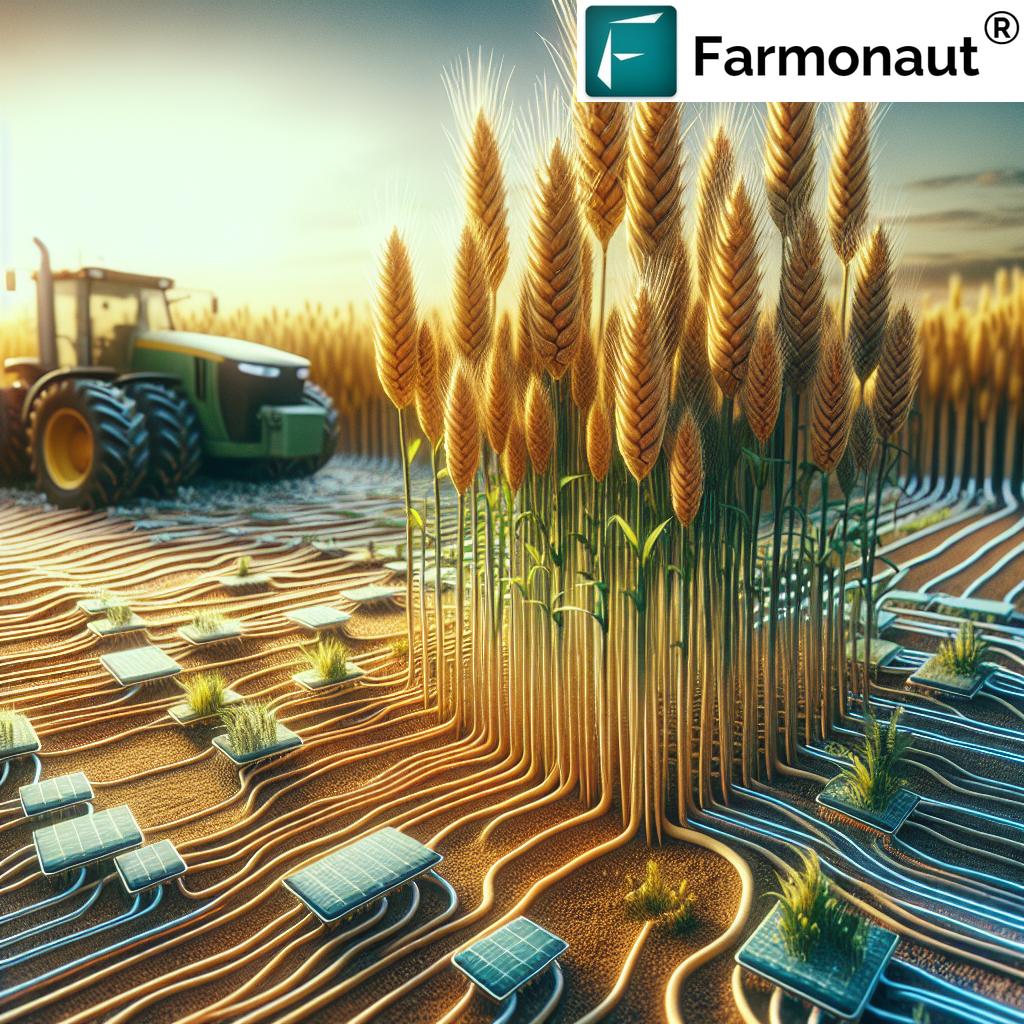Farm Management Made Easy: 7 Powerful Strategies for Success
- Introduction: The Power of Farm Management
- Overview: 7 Powerful Farm Management Strategies
- 1. Farm Business Planning
- 2. Financial Management and Risk Assessment
- 3. Human Resource Management
- 4. Strategic Marketing & Market Planning
- 5. Production Management: Crop & Livestock Operations
- 6. Integrated Farming Systems & Sustainable Practices
- 7. Technological Innovation: Digital Tools & Satellite Solutions
- Comparison Table: Impact of Farm Management Strategies
- Farmonaut Apps & Tools: Precision Agriculture for Everyone
- Continuous Education, Support Programs, and Farm Viability
- FAQ: Answers to Top Farm Management Challenges
- Conclusion: Transform Your Farm, Secure Your Future
Introduction: The Power of Farm Management for Modern Agricultural Success
Farm management is at the heart of modern agriculture, acting as the bridge between tradition and innovation. As we witness rapid technological advancements and growing challenges—like climate change, market fluctuations, and shifting environmental regulations—our ability to manage farms efficiently becomes crucial. Farm management involves much more than simply overseeing daily operations. It’s about strategically aligning every resource—land, labor, capital, and technology—to achieve optimal productivity, sustainability, and long-term profitability.
In this comprehensive guide, we’ll uncover 7 powerful strategies to enhance your farm management, drawing on best business planning practices, financial acumen, sustainable approaches, and the latest technology, including state-of-the-art solutions from Farmonaut. Whether you are an individual farmer, a large agribusiness, or a government agency, these strategies are your roadmap to boost productivity and ensure lasting viability in today’s demanding agricultural landscape.
Our journey covers:
- The key elements of farm management and agricultural business planning
- How to leverage technological solutions like satellite monitoring
- Ways to adopt sustainable farming practices
- Critical financial management tips for farmers
- Smart integration of human resources and marketing
- The significance of integrated farm management and agroforestry
- Seamless use of farm management software and modern data analytics
Overview: 7 Powerful Farm Management Strategies for Success
We believe every farm—regardless of size, region, or resource base—can become more productive, sustainable, and resilient by systematically applying these seven core management strategies:
- Farm Business Planning
- Financial Management & Risk Assessment
- Human Resource Management
- Marketing & Market Planning
- Production Management: Crop & Livestock
- Sustainable Integrated Farming & Conservation
- Technological Innovation & Data-Driven Decision Making
Each of these elements builds on the last, integrating best practices, robust systems, and technology-driven insights to enhance farm operations and secure lasting business viability.
1. Farm Business Planning: Setting Goals, Organizing Resources, Achieving Excellence
Farm business planning serves as the foundational cornerstone of successful farm management. It’s the process through which we set measurable goals, assess our resources, anticipate challenges, and develop robust strategies for every aspect of the farm. Strategic business planning not only helps farmers optimize daily operations but also prepares us to navigate risks, capitalize on opportunities, and adapt to changing market conditions.
Key Elements of Effective Business Planning:
- Defining Clear Objectives: What are our short-term and long-term business goals (yield targets, expansion, diversification)?
- Resource Assessment: Inventory land, labor, capital, equipment, and unique farm assets.
- Organizational Structure: Choose optimal business structures (sole proprietorship, cooperative, partnership, etc.).
- Risk Assessment: Identify and plan for environmental, financial, and market risks.
- Succession & Estate Planning: Plan for intergenerational transfer and business continuity.
- Action Plans: Assign responsibilities, set timelines, and establish performance metrics.
Modern tools like digital large-scale farm management apps streamline business planning by integrating resource scheduling, regulatory compliance, and data-driven insights.
Benefits of Structured Planning:
- Improved operational efficiency
- Enhanced adaptability to climate change and market fluctuations
- Clearer performance targets and more efficient resource allocation
2. Financial Management and Risk Assessment: Safeguarding Farm Profitability
Effective farm financial management is the backbone of every sustainable operation. By closely tracking income, expenditures, and cash flow, we equip ourselves to make sound decisions, cope with uncertainties, and invest confidently in the future. The difference between a thriving farm and a struggling one often comes down to disciplined financial planning and risk assessment.
Core Areas of Financial Management in Farming:
- Comprehensive Record-Keeping: Track sales, input costs, debt, machinery maintenance, and labor expenses.
- Budgeting & Forecasting: Predict seasonal expenditures, set income targets, and ensure liquidity to withstand uncertainties.
- Tax Management: Understand agricultural tax regulations at national and local levels to maximize returns.
- Credit, Loans & Insurance: Access satellite-verified farm loans and insurance solutions to expand operations and safeguard against financial risk.
- Risk Analysis: Evaluate exposure to commodity price swings, input cost increases, and unexpected weather or pest events.
- Cost-Benefit Analysis: Analyze the financial pros and cons of any new investment or operational change.
We encourage leveraging precision tools and farm management software for automated financial analytics, resource optimization, and real-time performance tracking—helping us make smarter financial moves, faster.
Support and Funding Programs:
- Government grants and incentive programs (check NIFA’s resources)
- Subsidies for technology adoption and conservation measures
3. Human Resource Management: Building a High-Performance Team on the Farm
No farm can flourish without a motivated, skilled, and well-managed team. Human resource management involves recruiting, training, developing, and retaining the right people for every task, from field labor and equipment operation to administrative roles and family participation.
We consider these HR priorities essential for optimal production and long-term business viability:
- Workforce Planning: Align labor needs with seasonal operations and peak demand periods.
- Hiring & Onboarding: Clearly define roles, responsibilities, and expectations.
- Ongoing Training: Upskill team members in the use of new machinery, farm management tools, biosecurity, and safety protocols.
- Performance Monitoring: Track productivity, provide constructive feedback, and set incentives.
- Succession/Intergenerational Transfer: Develop plans for estate transition and business continuity.
Best Practices:
- Foster two-way communication and responsive leadership
- Emphasize diversity, inclusion, and skills development
- Leverage digital fleet and labor management tools (Farmonaut fleet management capabilities)
4. Strategic Marketing: Unlocking Value in Agricultural Products
To truly thrive, we must not only produce but also sell effectively. Marketing encompasses every step from setting the right price, processing and distributing goods, to reaching the right consumers via optimal promotion and timing. The 4 P’s of marketing—Place, Price, Product, and Promotion—remain as relevant for farms as for any business.
Developing a Strong Market Plan:
- Market Research: Understand demand trends, competitive landscape, and consumer preferences.
- Pricing Strategies: Set profitable prices based on production cost, value addition, and market positioning.
- Product Differentiation: Emphasize freshness, traceability (blockchain-based traceability solutions), or organic certification.
- Distribution Channels: Consider local markets, cooperatives, direct-to-consumer sales, and digital platforms.
- Promotion: Use online marketing, community engagement, and certification-driven branding.
Link your physical products with authenticity, using advanced traceability software to guarantee quality and origin—building consumer trust and opening premium market opportunities.
5. Production Management: Optimizing Crop & Livestock Operations
At its core, production management is all about the physical processes involved in producing agricultural goods—be it crops, livestock, or specialized products like timber. It encompasses everything from resource allocation and land preparation to breeding, feeding, harvesting, and data-driven process optimization.
Modern Production Strategies Include:
- Land & Soil Management: Conduct soil testing, map fields, and implement conservation tillage.
- Water Use Efficiency: Use precision irrigation, monitor soil moisture via remote sensing advisory tools.
- Crop Planning: Choose optimal varieties, set planting/harvesting schedules based on forecasts, and implement crop rotation for soil health.
- Livestock Management: Optimize breeding cycles, animal feeding, housing, and health management.
- Pest and Disease Management: Deploy targeted pest control and resistance strategies, supported by real-time alerts from satellite systems.
- Equipment & Machinery: Schedule maintenance, track usage patterns, and invest in upgrades as needed.
Unlock even higher yields with AI-based crop and plantation advisory solutions for detailed, plot-specific guidance—driving decisions that minimize waste and maximize farm efficiency.
6. Integrated Farm Management & Sustainable Practices: Building Resilience for Generations
With rising global challenges and growing pressure for climate accountability, successful farmers must embrace integrated farm management and sustainable farming practices. By treating the farm as an interdependent ecosystem—where crop, livestock, forestry, and environmental needs are managed holistically—we can build resilience, boost biodiversity, and ensure the sustainability of our land and livelihoods.
Key Elements of Sustainable & Integrated Management:
- Agroforestry Systems: Integrate trees into cropland or pasture for improved yields, microclimate regulation, carbon sequestration, and erosion control.
- Conservation Practices: Implement cover cropping, reduced tillage, and buffer strips to protect soil and water.
- Biodiversity Enhancement: Encourage pollinators and natural pest predators by diversifying plantings.
- Resource Efficiency: Use waste recycling, composting, and nutrient cycling to close input-output loops.
- Integrated Pest Management (IPM): Combine biological, chemical, and cultural methods for robust pest control with minimal harm.
Programs such as the Forest Legacy Program underscore the importance of voluntary conservation and environmental stewardship for the future of forested landscapes.
With carbon footprinting and environmental monitoring tools from Farmonaut, we can now track and reduce our emissions, ensuring compliance with emerging global standards and enhancing the environmental performance—and reputation—of our operations.
7. Technological Innovation: Empowering Farms with Digital Tools & Data-Driven Management
In today’s world, technology is no longer optional for progressive farmers—it’s the catalyst for next-level productivity and sustainability. Technological advancements have ushered in the era of smart farming, transforming everything from decision making to environmental protection, allowing us to scale, optimize, and ensure transparency in every operation.
Leading Technologies in Modern Farm Management:
- Satellite-Based Crop Monitoring: Farmonaut’s satellite imagery platform lets us view real-time NDVI vegetation indices, soil moisture, and crop health at a glance—enabling pinpointed interventions and significant resource savings.
- AI-Powered Advisory Systems: Tools such as Jeevn AI deliver hyper-local recommendations, weather alerts, and tailored management strategies straight to our smartphone or desktop.
- Blockchain-Based Traceability: Ensure every crop or livestock product is traceable from farm to consumer, building market trust and reducing fraud.
- Fleet & Machinery Management: Digitally monitor vehicle and equipment use, reducing downtime and increasing ROI (fleet management platform).
- API Access and Integration: Slash integration time with weather and satellite data APIs for custom farm management or R&D needs: Farmonaut API (Developer Docs).
- Mobile Apps: Manage every aspect of the farm—from crop health to irrigation and fleet—on the go, with Android and iOS apps.
Unlike traditional precision agriculture tools—often expensive and hardware-dependent—Farmonaut democratizes access to advanced management by offering cost-effective, scalable solutions via satellite, AI, and web-based software. This makes data-driven farming and smart decision-making accessible to every farmer, business, or institution globally.
Comparison Table: Farm Management Strategies and Their Estimated Impact
| Strategy Name | Description | Estimated Productivity Increase (%) | Sustainability Impact | Technology / Innovation Involved | Estimated Implementation Cost ($) |
|---|---|---|---|---|---|
| Farm Business Planning | Systematic goal setting, resource allocation, and risk planning | 12 – 20% | Medium | Business analytics, digital planning tools | Low–Medium |
| Financial Management & Risk Assessment | Robust record-keeping, budgeting, and risk mitigation | 8 – 18% | Medium | Accounting software, analytics tools | Low–Medium |
| Human Resource Management | Efficient labor hiring, training, and succession planning | 6 – 15% | Low–Medium | Fleet/labor management systems | Medium |
| Marketing & Market Planning | Strategic pricing, product differentiation, and targeted selling | 9 – 21% | Medium | Digital marketing platforms, traceability tools | Low–Medium |
| Production Management | Optimized crop and livestock management, precision farming | 15 – 25% | Medium | Satellite & IoT monitoring, AI advisories | Medium–High |
| Integrated/Sustainable Farming | Agroforestry, conservation, environmental best practices | 10 – 16% | High | Soil/water monitoring, carbon tracking | Low–Medium |
| Technological Innovation | Satellite imagery, AI, blockchain, farm management software | 18 – 30% | High | Farmonaut technologies, automation, APIs | Medium–High |
Farmonaut Apps & Tools: Precision Agriculture for All Farms
At Farmonaut, we are committed to democratizing advanced farm management by providing affordable access to precision technologies through mobile, web, and API services—designed for farms of every scale.
- Real-time Crop Health Monitoring: Use satellite data for NDVI evaluation, soil moisture analysis, and pest risk assessment.
- AI-Based Advisory: Tap into Jeevn AI for instant, personalized management recommendations—empowering smarter decisions across all farming operations.
- Traceability & Transparency: Leverage blockchain tracking for supply chain confidence and market value.
- Environmental Sustainability: Monitor and reduce your carbon footprint with innovative sustainability tools.
- Fleet & Resource Optimization: Automate vehicle monitoring, logistics, and deployment for maximum operation efficiency (Fleet management).
- API Integration: Build your custom farm solution with our API (Developer Docs).
Our subscription-based service model ensures flexibility—choose weekly, monthly, or annual plans as per your needs, and scale software deployment seamlessly with farm growth.
Continuous Education, Support Programs & Ensuring Long-Term Farm Viability
The most successful farms make learning and adaptation a routine practice. Through ongoing education, training, and access to expert advisory resources, we can ensure our operations remain resilient to changing technologies, regulations, and market contexts.
- Professional Training: Enroll in Farm Business Management Programs for workshops, digital courses, and one-on-one coaching on business planning, financial assessment, and agri-marketing.
- Peer Networks: Join coops, farm groups, or local associations for knowledge sharing and group buying.
- Government and NGO Support: Tap into public and third-party support for subsidies, conservation funding, and disaster recovery programs.
Sustaining Farm Viability Amidst Global Change
- Anticipate climate change risks with adaptive crops/varieties, drought or flood resilience planning.
- Invest in continuous digitization and capacity-building.
- Encourage the next generation through planned intergenerational transfer and succession management—protecting legacy and ensuring future prosperity.
FAQ: Answers to Top Farm Management Challenges
What is farm management, and why is it important?
Farm management is the strategic organization and operation of all farm activities and resources—land, labor, capital—to maximize productivity, sustainability, and profitability. It’s crucial because it enables us to make data-driven decisions, anticipate and manage risk, and adapt proactively to economic and environmental changes.
How can technology help me manage my farm more efficiently?
Technology transforms farm efficiency through real-time monitoring (e.g., satellite crop health), AI-based management advisories, blockchain traceability, resource management tools, and mobile farm management apps. These systems optimize inputs, minimize waste, and provide instant field insights for informed decision-making.
What are integrated farm management & agroforestry, and how do they benefit farms?
Integrated farm management combines crop, livestock, forestry, and sustainability practices to create a robust, diversified, and lower-risk system. Agroforestry adds value by incorporating trees with crops or livestock—improving soil, increasing biodiversity, supporting carbon sequestration, and providing additional income streams.
How can I monitor my carbon footprint and improve environmental sustainability?
Use digital tools like Farmonaut’s carbon footprinting platform to track greenhouse gas emissions and resource use in real time. By identifying hotspots, you can implement precise reductions (conservation tillage, optimized irrigation, biodiversity measures) and achieve compliance with global standards.
Which apps or tools can help me manage my crop, livestock, and forestry operations?
Farmonaut offers a suite of farm management software—including the Agro Admin App, satellite-based monitoring, AI-powered advisories, blockchain traceability, and resource management solutions—all accessible via web, Android, iOS, and API.
How should I plan for succession and ensure long-term viability?
Effective succession and estate planning involve involving family members or trusted employees in management tasks early, establishing clear business structures, and documenting plans for ownership transfer. Consider enrolling in dedicated farm business management courses for step-by-step guidance.
Conclusion: Transform Your Farm, Secure Your Future with Smart Management
In today’s ever-evolving agricultural landscape, successful farm management is about more than tradition—it’s about embracing robust business planning, financial discipline, sustainable farming practices, technological innovation, and a whole-systems approach (integrated farming, agroforestry, conservation). By strategically weaving these seven powerful strategies into our daily operations, we unlock increased productivity, resource efficiency, and profitability—safeguarding our farms for generations to come.
With precision tools from Farmonaut—spanning satellite intelligence, AI, blockchain traceability, and mobile solutions—we can manage every resource smartly, adapt rapidly to global change, and maximize every opportunity the modern agricultural world has to offer.
Start your journey to farm success today—empowering your land, people, and products through informed, integrated, and innovative management.










